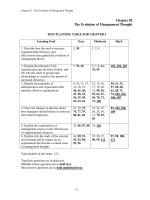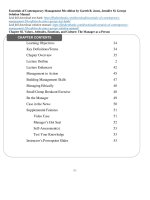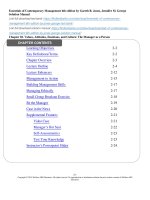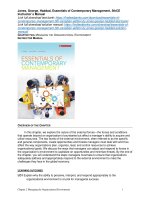Essentials of contemporary management 6th edition by jones george test bank
Bạn đang xem bản rút gọn của tài liệu. Xem và tải ngay bản đầy đủ của tài liệu tại đây (708.45 KB, 222 trang )
Essentials of Contemporary Management 6th edition by Gareth R. Jones, Jennifer M.
George Test Bank
Link full download test bank: />Link full download solution manual: />
Chapter 02. Values, Attitudes, Emotions, and Culture: The Manager as a Person
True / False Questions
1.
Personality traits are the enduring tendencies to feel, think, and act in certainways.
True False
2.
The effectiveness of managers is determined by a complex interaction between the characteristics of
managers and the nature of the job and organization in which they are working.
True False
3.
Personality traits enhance managerial effectiveness in all
situations. True False
4.
Managers who are low on extraversion are not efficient even in jobs that require very little
social interaction.
True False
5.
The tendency of a manager to feel distressed and to be critical of himself/herself and others
is called negative affectivity.
True False
2-1
Copyright © 2015 McGraw-Hill Education. All rights reserved. No reproduction or distribution without the prior written consent of
McGraw-Hill Education.
6.
Managers who are low on agreeableness are, in all likelihood, strongly antagonistic most of
the time.
True False
7.
A low level of agreeableness is an asset in managerial jobs that actually requires that managers
be antagonistic.
True False
8.
Managers who are high on the conscientiousness continuum are organized and self-disciplined.
True False
9.
Managers who are low on openness might be an asset in certain organizations and
positions. True False
10. Managers need an external locus of control because they are responsible for what happens
in organizations.
True False
11. Since managers are accountable for ensuring that organizations and their members behave in
an ethical fashion, they need an external locus of control.
True False
2-2
Copyright © 2015 McGraw-Hill Education. All rights reserved. No reproduction or distribution without the prior written consent of
McGraw-Hill Education.
12. The need for achievement is the extent to which an individual is concerned about establishing
and maintaining good interpersonal relations, being liked, and having the people around him/her
get along with one another.
True False
13. The need for affiliation is the extent to which a manager has a strong interest in
performing challenging tasks well and to meet personal standards of excellence.
True False
14. Research suggests that a high need for affiliation is especially important for upper-level
managers. True False
15. A personal conviction about lifelong goals or objectives is called a terminal
value. True False
16. The terminal and instrumental values that are guiding principles in an individual's life are known
as norms.
True False
17. A sense of accomplishment and a strong desire for equality are examples of instrumental
values. True False
18. Levels of job satisfaction tend to increase as one moves up the hierarchy in an
organization. True False
2-3
Copyright © 2015 McGraw-Hill Education. All rights reserved. No reproduction or distribution without the prior written consent of
McGraw-Hill Education.
19. Satisfied managers are more likely to perform organizational citizenship behaviors than
dissatisfied managers.
True False
20. Downsizing tends to increase employee satisfaction because employees' increased workloads
make them feel more responsible and empowered.
True False
21. Helping layoff victims in their job search efforts is one of the ways in which managers can
humanely manage a layoff.
True False
22. Organizational commitment is likely to help managers perform some of their figurehead
and spokesperson roles.
True False
23. Differences in the levels of organizational commitment among managers in different countries
are likely because these managers have different kinds of opportunities and rewards.
True False
24. People who are high on extraversion are especially likely to experience positive
moods. True False
25. People who are high on negative affectivity are always in a bad
mood. True False
2-4
Copyright © 2015 McGraw-Hill Education. All rights reserved. No reproduction or distribution without the prior written consent of
McGraw-Hill Education.
26. Emotions are more intense feelings than moods and are long-
lived. True False
27. Studies conducted over time have suggested that critical thinking is promoted by negative
moods. True False
28. Emotional intelligence concerns understanding and managing the moods and emotions of
others but not oneself.
True False
29. Emotional intelligence helps managers perform their interpersonal
roles. True False
30. When organizational members share an intense commitment to cultural values, beliefs,
and routines and use them to achieve their goals, a strong organizational culture exists.
True False
31. The personal characteristics of the founders of an organization have an important role in
the creation of the organization's culture.
True False
32. The attraction-selection-attrition framework suggests that employees who are dissimilar in
personality from that of the founders are more likely to leave the organization over time.
True False
2-5
Copyright © 2015 McGraw-Hill Education. All rights reserved. No reproduction or distribution without the prior written consent of
McGraw-Hill Education.
33. The terminal values and not the instrumental values of managers play a role in
determining organizational culture.
True False
34. Both values and norms help managers to determine and shape the organizational
culture. True False
35. Organizational socialization is the process by which newcomers learn an organization's values
and norms and acquire the work behaviors necessary to perform jobs effectively.
True False
36. Rites of passage such as shared announcements of organizational successes, office parties,
and company cookouts, build and reinforce common bonds among organizational members.
True False
37. Rites of integration help build common norms and
values. True False
38. Stories (only factual) about organizational heroes and villains and their actions provide
important clues about values and norms.
True False
39. Top managers in an organization with an innovative culture are likely to emphasize formal
top-down planning.
True False
2-6
Copyright © 2015 McGraw-Hill Education. All rights reserved. No reproduction or distribution without the prior written consent of
McGraw-Hill Education.
40. In an innovative culture, managers are likely to lead by example, encouraging employees to
take risks and experiment.
True False
Multiple Choice Questions
41. An individual's enduring tendency to feel, think, and act in certain ways are referred to as his/her:
A. personality traits.
B. terminal values.
C. norms.
D. attitudes.
E. moods.
42. What are the big five personality traits?
A. Extraversion, tension, perfectionism, self-reliance, and apprehension
B. Extraversion, negative affectivity, agreeableness, conscientiousness, and openness to experience
C. Extraversion, negative affectivity, agreeableness, conscientiousness, and tension
D. Extraversion, negative affectivity, agreeableness, tension, and perfectionism
E. Extraversion, negative affectivity, tension, perfectionism, and self-reliance
2-7
Copyright © 2015 McGraw-Hill Education. All rights reserved. No reproduction or distribution without the prior written consent of
McGraw-Hill Education.
43. The tendency to experience positive emotions and moods and feel good about oneself and the
rest of the world is known as:
A. conscientiousness.
B. openness to experience.
C. rationality.
D. extraversion.
E. social recognition.
44. People who tend to be sociable, outgoing, and friendly are said to:
A. be extraverts.
B. be introverts.
C. have low self-esteem.
D. be conscientious.
E. have an internal locus of control.
45. Max enjoys being the center of attraction during his office parties. He has excellent social skills
and easily makes friends with new employees. He can rightly be said to:
A. have an internal locus of control.
B. be an extravert.
C. have a low self-esteem.
D. be an introvert.
E. be conscientious.
2-8
Copyright © 2015 McGraw-Hill Education. All rights reserved. No reproduction or distribution without the prior written consent of
McGraw-Hill Education.
46. People who are less inclined toward social interactions and to have a less positive outlook
are known to be:
A. optimistic.
B. dominant.
C. introverts.
D. agreeable.
E. extraverts.
47. Steven is an effective and efficient manager. However, he is quite pessimistic and avoids
social interactions. Steven can be classified as an:
A. extravert.
B. individual with a high external locus of control.
C. individual with high self-esteem.
D. introvert.
E. individual who is open to change.
48. The tendency of a person to feel bad emotions and moods, to feel distressed, and to be critical
of oneself and others is called:
A. agreeableness.
B. conscientiousness.
C. negative affectivity.
D. high on self-esteem.
E. optimism.
2-9
Copyright © 2015 McGraw-Hill Education. All rights reserved. No reproduction or distribution without the prior written consent of
McGraw-Hill Education.
49. Edward, a manager at Real Corp., is a very positive individual. He rarely exhibits adverse emotions or
moods and is always optimistic about himself and others. It can be said that Edward is:
A. low on negative affectivity.
B. low on agreeableness.
C. high on conscientiousness.
D. high on self-esteem.
E. an extravert.
50. The tendency to get along well with others is known as:
A. need for affiliation.
B. agreeableness.
C. conscientiousness.
D. self-esteem.
E. need for achievement.
51. Penelope is a manager with Quick Pizza. She is very good at understanding the feelings of her
subordinates and takes time out for all of them. She listens to their problems, sympathizes with
them, and tries her best to give them solutions regarding the same. From this information, it can
be said that Penelope is:
A. an introvert.
B. a pessimist.
C. high on agreeableness.
D. low on conscientiousness.
E. high on ambition.
2-10
Copyright © 2015 McGraw-Hill Education. All rights reserved. No reproduction or distribution without the prior written consent of
McGraw-Hill Education.
52. ________________ is the tendency to be careful, scrupulous, and persevering.
A. Conscientiousness
B. Openness to experience
C. Need for achievement
D. Agreeableness
E. Extraversion
53. Managers who are ________________ appear to lack direction and self-discipline.
A. low on negative affectivity
B. low on conscientiousness
C. low on agreeableness
D. extraverts
E. optimists
54. ________________ is the tendency to be original, have broad interests, be daring, and take risks.
A. Agreeableness
B. Conscientiousness
C. Openness to experience
D. Introversion
E. Negative affectivity
2-11
Copyright © 2015 McGraw-Hill Education. All rights reserved. No reproduction or distribution without the prior written consent of
McGraw-Hill Education.
55. As a manager, Nancy is known in the company as a risk-taker and an innovator. Nancy is:
A. high on introversion.
B. low on agreeableness.
C. high on openness to experience.
D. high on negative affectivity.
E. high on conscientiousness.
56. Brian has been employed at Precision Services for nearly 10 years. He is an effective manager,
but does not like to take risks. Brian is more comfortable following guidelines and maintaining
the status quo. Brian is:
A. low on conscientiousness.
B. high on extraversion.
C. high on agreeableness.
D. low on openness to experience.
E. high on the need for affiliation.
57. People who have ________________ believe they themselves are responsible for their own fate;
they see their own actions and behaviors as being major and decisive determinants of important
outcomes.
A. low self-esteem
B. a low sense of achievement
C. high neuroticism
D. an internal locus of control
E. an external locus of control
2-12
Copyright © 2015 McGraw-Hill Education. All rights reserved. No reproduction or distribution without the prior written consent of
McGraw-Hill Education.
58. Whenever Cate does not perform well in a test, she blames it on the lack of preparedness on
her part. Cate is said to have:
A. an external locus of control.
B. low self-esteem.
C. a low sense of achievement.
D. high neuroticism.
E. an internal locus of control.
59. People who believe that outside forces are responsible for what happens to and around them
and do not think that their own make much of a difference have:
A. a high sense of achievement.
B. less neuroticism.
C. an internal locus of control.
D. an external locus of control.
E. high self-esteem.
60. Whenever Daniel performs well in a test, he thinks that his teacher was being lenient or that he
was lucky. Daniel is said to have:
A. an internal locus of control.
B. high self-esteem.
C. a high sense of achievement.
D. low neuroticism.
E. an external locus of control.
2-13
Copyright © 2015 McGraw-Hill Education. All rights reserved. No reproduction or distribution without the prior written consent of
McGraw-Hill Education.









